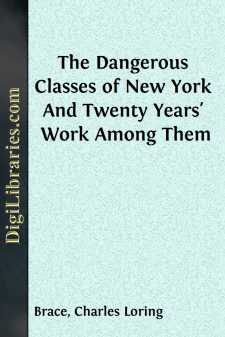Categories
- Antiques & Collectibles 13
- Architecture 36
- Art 48
- Bibles 22
- Biography & Autobiography 813
- Body, Mind & Spirit 142
- Business & Economics 28
- Children's Books 17
- Children's Fiction 14
- Computers 4
- Cooking 94
- Crafts & Hobbies 4
- Drama 346
- Education 46
- Family & Relationships 57
- Fiction 11829
- Games 19
- Gardening 17
- Health & Fitness 34
- History 1377
- House & Home 1
- Humor 147
- Juvenile Fiction 1873
- Juvenile Nonfiction 202
- Language Arts & Disciplines 88
- Law 16
- Literary Collections 686
- Literary Criticism 179
- Mathematics 13
- Medical 41
- Music 40
- Nature 179
- Non-Classifiable 1768
- Performing Arts 7
- Periodicals 1453
- Philosophy 64
- Photography 2
- Poetry 896
- Political Science 203
- Psychology 42
- Reference 154
- Religion 513
- Science 126
- Self-Help 84
- Social Science 81
- Sports & Recreation 34
- Study Aids 3
- Technology & Engineering 59
- Transportation 23
- Travel 463
- True Crime 29
The Dangerous Classes of New York And Twenty Years' Work Among Them
Description:
Excerpt
INTRODUCTION.
——-
The great pioneer in the United States, in the labors of penal Reform and the prevention of crime,—EDWARD LIVINGSTON,—said as long ago as 1833, in his famous "Introductory Report to the Code of Reform and Prison Discipline": "As prevention in the diseases of the body is less painful, less expensive, and more efficacious than the most skillful cure, so in the moral maladies of society, to arrest the vicious before the profligacy assumes the shape of crime; to take away from the poor the cause or pretence of relieving themselves by fraud or theft; to reform them by education and make their own industry contribute to their support, although difficult and expensive, will be found more effectual in the suppression of offences and more economical than the best organized system of punishment."—(p. 322.)
My great object in the present work is to prove to society the practical truth of Mr. Livingston's theoretical statement: that the cheapest and most efficacious way of dealing with the "Dangerous Classes" of large cities, is not to punish them, but to prevent their growth; to so throw the influences of education and discipline and religion about the abandoned and destitute youth of our large towns, to change their material circumstances, and draw them under the influence of the moral and fortunate classes, that they shall grow up as useful producers and members of society, able and inclined to aid it in its progress.
In the view of this book, the class of a large city most dangerous to its property, its morals and its political life, are the ignorant, destitute, untrained, and abandoned youth: the outcast street-children grown up to be voters, to be the implements of demagogues, the "feeders" of the criminals, and the sources of domestic outbreaks and violations of law.
The various chapters of this work contain a detailed account of the constituents of this class in New York, and of the twenty years' labors of the writer, and many men and women, to purify and elevate it; what the principles were of the work, what its fruits, what its success.
So much interest at home and abroad has been manifested in these extended charities, and so many inquiries are received continually about them, that it seemed at length time to give a simple record of them, and of the evils they have sought to cure.
If the narrative shall lead the citizens of other large towns to inaugurate comprehensive and organized movements for the improvement of their "Dangerous Classes," my object will be fully attained.
I have the hope, too, that these little stories of the lot of the poor in cities, and the incidents related of their trials and temptations, may bring the two ends of society nearer together in human sympathy.
The discussion of the Causes of Juvenile Crime contained in this work must aid others who would found similar reformatory and preventive movements, to base them on principles and motives which should reach similar profound and threatening evils.


